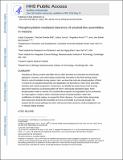Phosphorylation-Mediated Clearance of Amyloid-like Assemblies in Meiosis
Author(s)
Carpenter, Kayla; Bell, Rachel Brietta; Yunus, Julius; Amon, Angelika B; Berchowitz, Luke Edwin
DownloadAccepted version (2.116Mb)
Terms of use
Metadata
Show full item recordAbstract
Amyloids are fibrous protein assemblies that are often described as irreversible and intrinsically pathogenic. However, yeast cells employ amyloid-like assemblies of the RNA-binding protein Rim4 to control translation during meiosis. Here, we show that multi-site phosphorylation of Rim4 is critical for its regulated disassembly and degradation and that failure to clear Rim4 assemblies interferes with meiotic progression. Furthermore, we identify the protein kinase Ime2 to bring about Rim4 clearance via phosphorylation of Rim4's intrinsically disordered region. Rim4 phosphorylation leads to reversal of its amyloid-like properties and degradation by the proteasome. Our data support a model in which a threshold amount of phosphorylation, rather than modification of critical residues, is required for Rim4 clearance. Our results further demonstrate that at least some amyloid-like assemblies are not as irreversible as previously thought. We propose that the natural pathways by which cells process these structures could be deployed to act on disease-related amyloids. Amyloids, fibrous protein assemblies associated with numerous diseases, are often referred to as being irreversible structures. Carpenter et al. demonstrate that, in coordination with meiotic development, budding yeast are able to disassemble and clear the amyloid-like translational repressor Rim4 by multi-site phosphorylation of residues within disordered regions of the protein.
Date issued
2018-05Department
Massachusetts Institute of Technology. Department of Biology; Koch Institute for Integrative Cancer Research at MITJournal
Developmental Cell
Publisher
Elsevier BV
Citation
Carpenter, Kayla et al. "Phosphorylation-Mediated Clearance of Amyloid-like Assemblies in Meiosis." Developmental Cell 45, 3 (May 2018): P392-405.e6 © 2018 Elsevier Inc
Version: Author's final manuscript
ISSN
1534-5807